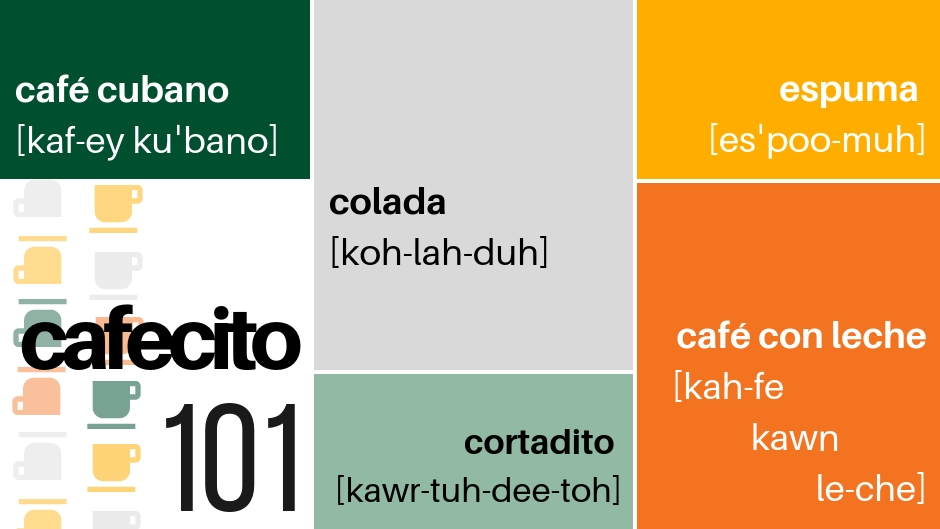Ask any Cuban to name their must-have beverages and you will inevitably hear them mention the café cubano. For many this drink is a comfort food, one served to welcome guests to their homes or after finishing a meal together—at times even replacing a meal or serving as a late-night snack. It’s what you make for a family member or friend who has received some news—good or bad. It’s at the center of many a social gathering where conversations about politics or reminiscences of good old times abound. Regardless of the stage—or age—in someone’s life, some may argue a good cafecito will nourish more than just hunger or thirst.
Ready to make traditional café cubano yourself at home? Here's what you'll need:
- Stovetop espresso maker—usually metal, bottom chamber filled with water just to the valve
- Cuban-style coffee—typically Italian or Spanish roasts; Café Bustelo, Pilon, and Café La Llave
- Sugar—the key ingredient, measure about half a tablespoon per serving
- Glass or metal pitcher—for stirring perfectly whipped espuma
- Demitasse cups—to serve about two to three fluid ounces per person
PRO TIP: Always place the espresso maker on the stove over medium heat and slightly to one side so you don’t accidentally burn the plastic handle.
PRO TIP: If the stream of coffee explodes upward in the upper chamber of the pot, your water is too hot. If it burbles lethargically, turn up the heat. You’ll know it’s done when you hear a hissing, bubbling sound—the sound of sweet perfection.
The Lingo
Café Cubano • [kaf-ey kuˈbano]
Also known as cafecito, this Cuban original is a staple in Miami—from ventanitas, or small windows that serve coffee and snacks, to abuela’s homemade, everyone has their favorite.
The secret to the creating the cafecito everyone craves? The first and strongest drops of steamy espresso are hand whipped with pure cane sugar, creating the recognizable—and taste tested—sweet caffeinated goodness. Classic. Traditional. Perfect. Need we say more?
Café con leche • [kah-fe kawn le-che]
This Miami favorite is the perfect blend of its namesake, coffee with milk. But it’s so much more than your average latte. Dark espresso and steamed milk are blended and stirred to perfection.
Enjoy this beverage with a traditional Cuban breakfast served with slices of buttered, toasted Cuban bread, called tostadas. Pro tip: Try dunking your tostadas in the coffee for bonus (Cuban) points!
Cortadito • [kawr-tuh-dee-toh]
While the ratio of milk to espresso may be a personal preference (50/50 or 75/25), cortadito lovers can be specific when ordering a standard shot of espresso topped with steamed milk. Many prefer the cortadito with evaporated milk for a richer taste. Looking for more coffee than milk? Order it oscuro, or dark—you’ll thank us later.
Not to be confused with a cortado, which is a beverage consisting of espresso mixed with a roughly equal amount of warm milk that is steamed, but not frothy and texturized as in many Italian coffee drinks. Cortado is the past participle of the Spanish verb cortar—meaning to cut, in the sense of "dilute," and can refer to either coffee or espresso drinks throughout Spain, Portugal, and Cuba.
Espuma • [esˈpu.ma]
What’s Cuban coffee without espuma? We have no idea. This foamy and creamy top layer, endearingly referred to as espumita, is the sign that your coffee was made with love—and sugar. Made by vigorously stirring—almost beating—the first teaspoon of the brewed coffee into a small vessel of sugar with a spoon until it forms a nice, frothy mixture. This process creates a sweeter and slightly more viscous result than simply adding sugar to your coffee at the table.
Colada • [koh-lah-duh]
We’re far from piñas (pineapples), people! This Cuban-style drink contains three to six shots of espresso, which served in a disposable cup, is then subdivided in thimble-sized, plastic demitasse cups—and sipped slowly and meaningfully or thrown back quickly as you would a shot of alcohol. Coladas are meant to be shared among a group and can make for a nice, communal break treat. Become the office favorite today by bringing one of these bad boys around the office at 3:05 p.m.!
Fun Facts
- Demitasse (dem-E-tas) is French for "half cup." They are half the size of a regular coffee cup, hence the name "half cup." These cups are most often used to serve Turkish coffee, espresso—either single shots or "doppio," which means double shots, and other highly concentrated coffee drinks, such as Greek coffee.
- The moka pot, named after Mocha, Yemen—a port city bordering the Red Sea that was once a coffee hub—was invented by an engineer named Alfonso Bialetti in 1933. Bialetti Industrie continues to produce the same model under the name moka express. Spreading from Italy, the moka pot is most commonly used today in Europe and in Latin America. Similar to a pressure cooker, this eight-sided appliance uses pressure to brew coffee, including the café cubano. These pots, which can be found in varying sizes, are traditionally made from aluminum but also come in stainless steel, and cost very little.

